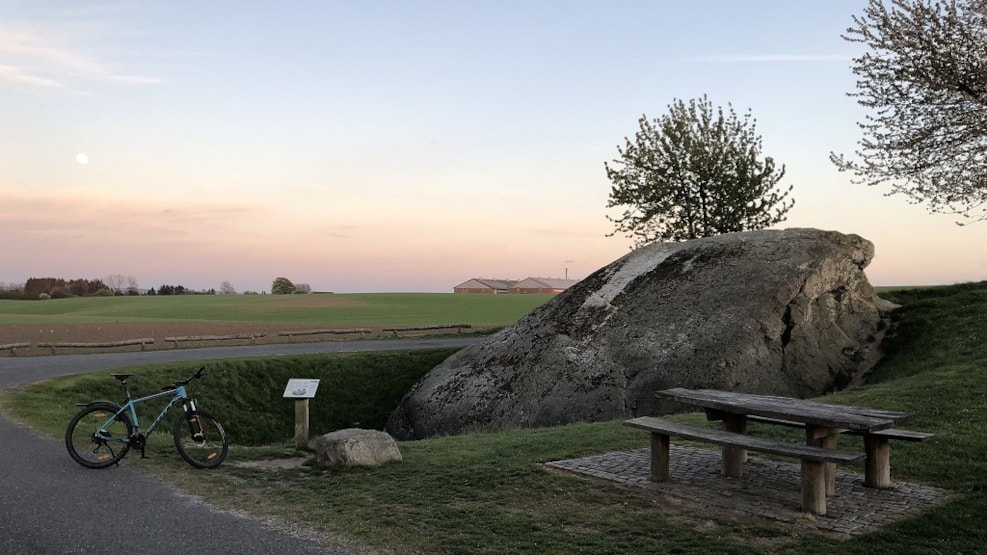
The Witch and Denmark’s Largest Stone (33 km)
The tour starts at Alma's House in Ørbæk. This old, yellow farmhouse has a unique history and its roots can be traced back to the 17th century. Alma's House is currently being developed as a hub for cycling tours and experiences in Ørbæk.
Frørup
From Alma's House, we ride northeast. Follow route 51 and then 79. Frørup is a charming little village. The church is located at the village square, and from here, the small village spreads out. In the southern part of the village, you will find Regisse Spring. In the Middle Ages, the spring was a holy well, a destination for many pilgrims seeking healing from the spring and the nearby church. Today, on the road between the church and the spring, you will find Frørup Vineyard. Whether a higher power has transformed the holy water into wine, or if the wine offers healing, we shall leave unsaid. However, it is quite true that this small vineyard has won awards for its wine and is worth a stop on your trip.
Kongshøj Mill
Kongshøj Mill is reflected in its mill pond. Take a moment here at the small rest area and enjoy the view across the lake and the mirrored image of the mill, while you listen to the gurgling and rushing water flowing behind you. The mill originally belonged to Glorup Manor, which you will come to later in the tour. From Kongshøj Mill, you have the option of taking a detour or a shortcut via Øksendrup. Here you will find, among other things, Øksendrup Church. In the church, you will find a relic from when Denmark was Catholic, and pilgrims traveled to places like Øksendrup Church. Later, the Reformation removed this reason for travel, but the relic in Øksendrup Church survived, and you can visit it today. If you continue this detour, you will pass the manor of Anhof on your way to Glorup Manor, which you will also reach by continuing on the planned route.
Damestenen
Damestenen is Denmark's largest stone. The stone is located between Vormark and Hesselager. There are two stories about Damestenen. One is that the stone is a so-called erratic boulder, which was carried here during the last ice age from southern Sweden. The other story is that a witch from Langeland was angry with the priest in Svindinge village. The witch picked up a stone, aimed at the spire of Svindinge Church and threw it. An angel, however, was on the priest's side, descended from heaven and stepped on the stone, causing it to fall to the ground. On top of the stone, there is reportedly still an imprint of an angel's foot. Denmark's largest stone – regardless of how it got here – is estimated to be about 10 meters tall, have a circumference of about 45.8 meters and weigh more than 1,000 tons.
From Wool to Castle Wedding
The tour continues towards Langå. On your way, you'll pass Hjelholt Uldspinderi (Hjelholt Wool Mill). Besides supplying wool, the sheep graze on several of Holckenhavn Castle's fields around Nyborg. Many of these fields are organically farmed by Rosilde Højgaard and their food products can be purchased in their farm shop in Nyborg, but are also used at Holckenhavn Castle for things like weddings, meetings, and conferences. Holckenhavn Castle is not a stop on this bike tour, but we recommend trying some of the other bike tours that take you closer to Nyborg and Holckenhavn.
Glorup Manor and Park
After Langå, the route continues past Glorup Manor. H.C. Andersen often stayed here and wrote fairy tales and poems at Glorup. The park in particular – which is open to the public and free of charge – is well worth a visit. Park your bike in the car park after the manor and explore on foot. The park contains a mirror lake and a large number of sculptures. If you're up for a real adventure, at the bottom of the park you'll find the towers of the old suspension bridge. Here, you'll truly be transported back in time – but you'll also have to explore to find the towers.
Svindinge Church
Shortly after Glorup, you'll reach Svindinge. Here, the church is situated by the village pond, making it a natural place to stop. The spire of the church was the target of the witch from Langeland, according to a local legend. Additionally, Svindinge Church is one of only two village churches in Denmark built during the Renaissance period, making it quite unique compared to the many churches from the Catholic era.
Ørbæk
On your way back to Ørbæk, you'll ride towards Frørup, Regisse Spring, and Frørup Vineyard again. This time, you'll pass "Regissebakken" (Regisse Hill), which is considered by local cyclists to be an almost mythical steep hill. However, if you've followed this route guide, you'll be cycling downhill. Back in Ørbæk, one of the first things you'll see is Ørbæklunde Manor. The manor was established in the 16th century as the last manor house in Denmark and was originally the area's defense fortress. Ørbæk Church is particularly known for its chalk paintings. If you need a sweet treat, we suggest visiting the local bakery for a piece of Brunsviger cake – a Funen specialty that we also refer to as "brunner".